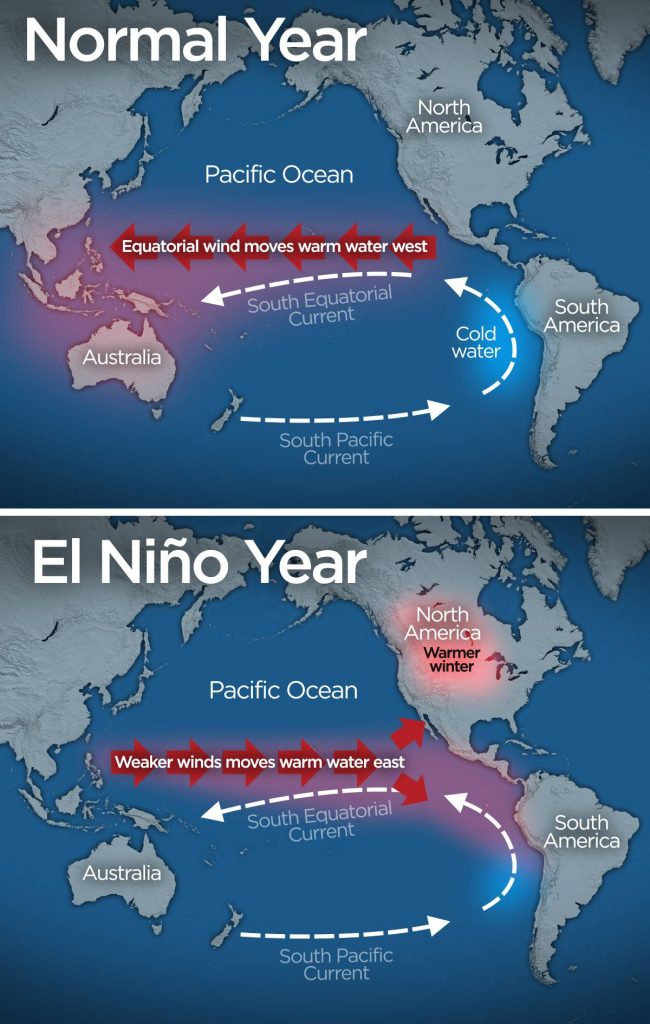Focus: GS-I Geography
Why in news?
The La Niña weather phenomenon is back in the central and eastern equatorial Pacific Ocean after nearly a decade’s absence, the World Meteorological Organization (WMO) said in its latest Global Seasonal update released in October 2020.
The Current La Niña
- La Niña will result in sea surface temperatures between two and three degrees Celsius cooler than average.
- However, 2020 is on track to be one of the warmest years on record and 2016-2020 is expected to be the warmest five-year period on record.
- La Niña could last into 2021, affecting temperatures, precipitation and storm patterns in many parts of the world, according to WMO.
- There is a high possibility (90 per cent) of tropical Pacific sea surface temperatures remaining at La Niña levels through the end of 2020 and maybe through the first quarter of 2021 (55 per cent).
- The La Niña of 2020 is expected to be moderate to strong. The last time there was a strong La Niña event, was in 2010-2011, followed by a moderate event in 2011-2012.
- There were a series of floods in Pakistan and Northwest India in 2010 that were attributed to the weather phenomenon.
- The Horn of Africa and central Asia will see below average rainfall due to La Niña, WMO said.

La Niña
- La Niña is a coupled ocean-atmosphere phenomenon that is the colder counterpart of El Niño, as part of the broader El Niño–Southern Oscillation (ENSO) climate pattern.
- is a coupled ocean-atmosphere phenomenon that is the colder counterpart of El Niño, as part of the broader El Niño–Southern Oscillation (ENSO) climate pattern.
- During a period of La Niña, the sea surface temperature across the equatorial Eastern Central Pacific Ocean will be lower than normal by 3 to 5 °C (5.4 to 9 °F).
- An appearance of La Niña persists for at least five months.
- It has extensive effects on the weather across the globe, particularly in North America, even affecting the Atlantic and Pacific hurricane seasons, in which more tropical cyclones occur in the Atlantic basin due to low wind shear and warmer sea surface temperatures, while reducing tropical cyclogenesis in the Pacific Ocean.
- La Niña is a complex weather pattern that occurs every few years, as a result of variations in ocean temperatures in the Equatorial Pacific.
- It occurs as strong winds blow warm water at the ocean’s surface from South America across the Pacific Ocean towards Indonesia.
- As this warm water moves west, cold water from the deep sea rises to the surface near South America.
- As a result, it is considered to be the cold phase of the broader El Niño–Southern Oscillation weather pattern, as well as the opposite of El Niño weather pattern.
- La Niña impacts the global climate and disrupts normal weather patterns, which as a result can lead to intense storms in some places and droughts in others.

El Niño
- El Niño is the warm phase of the El Niño–Southern Oscillation (ENSO) and is associated with a band of warm ocean water that develops in the central and east-central equatorial Pacific (between approximately the International Date Line and 120°W), including the area off the Pacific coast of South America.
- The ENSO is the cycle of warm and cold sea surface temperature (SST) of the tropical central and eastern Pacific Ocean.
- El Niño is accompanied by high air pressure in the western Pacific and low air pressure in the eastern Pacific.
- During the development of El Niño, rainfall develops between September–November.
- The cool phase of ENSO is La Niña, with SSTs in the eastern Pacific below average, and air pressure high in the eastern Pacific and low in the western Pacific.
- The ENSO cycle, including both El Niño and La Niña, causes global changes in temperature and rainfall.
-Source: Down to Earth Magazine




